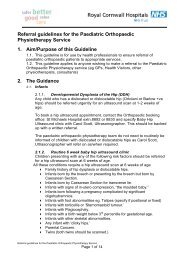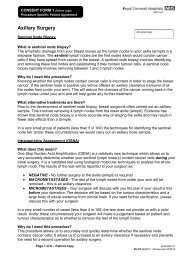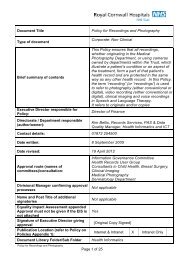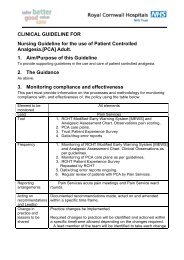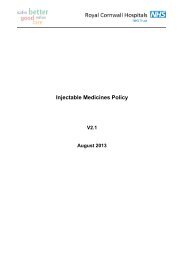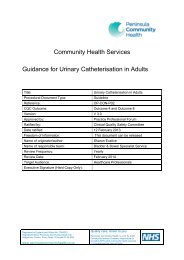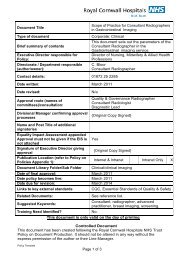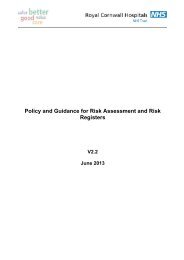Policy for the Prescription, Administration and Monitoring Of Oxygen ...
Policy for the Prescription, Administration and Monitoring Of Oxygen ...
Policy for the Prescription, Administration and Monitoring Of Oxygen ...
- No tags were found...
You also want an ePaper? Increase the reach of your titles
YUMPU automatically turns print PDFs into web optimized ePapers that Google loves.
‣ Patients receiving oxygen as part of palliative care, or patients on <strong>the</strong> end of life carepathway (in which case <strong>the</strong> prescriber should choose 'target saturations not indicated'on <strong>the</strong> drug chart/JAC EPMA system).6.7. Specialist areasThis policy is <strong>for</strong> general use within general wards <strong>and</strong> department. Where specific clinicalguidelines are required oxygen administration within specialist areas, <strong>the</strong>y must beapproved via <strong>the</strong> appropriate clinical governance <strong>for</strong>um. They should reflect whereverpossible <strong>the</strong> principles within this policy. Patients transferring from specialist areas mustbe transferred with a prescription <strong>for</strong> <strong>the</strong>ir oxygen <strong>the</strong>rapy utilising target saturation if <strong>the</strong>clinical indication is ongoing. If a patient transfers from an area not utilising <strong>the</strong> targetsaturation system, <strong>the</strong>ir oxygen should be administered as per <strong>the</strong> transferring area'sprescription until <strong>the</strong> patient is reviewed <strong>and</strong> transferred over to <strong>the</strong> target saturationscheme <strong>and</strong> this should occur as soon as possible.6.8. IndicationsThe rationale <strong>for</strong> oxygen <strong>the</strong>rapy is prevention of cellular hypoxia, caused by hypoxaemia(low PaO 2 ) <strong>and</strong> thus prevention of potentially irreversible damage to vital organs.<strong>Oxygen</strong> is not a treatment <strong>for</strong> breathlessness <strong>and</strong> o<strong>the</strong>r caused of tissue hypoxia e.g.anaemia, ischaemia must be addressed. Indications <strong>for</strong> oxygen <strong>the</strong>rapy are listed inAppendix a.6.9 Contra-indicationsThere are no absolute contra-indications to oxygen <strong>the</strong>rapy if indications are judged to bepresent. <strong>the</strong> goal of oxygen <strong>the</strong>rapy is to achieve adequate tissue oxygenation using <strong>the</strong>lowest possible Fi0 2 . Supplemental oxygen should be administered with caution inpatients suffering from paraquat poisoning <strong>and</strong> with acid inhalation or previous belomycinlung injury.6.10 Cautions6.10.1 <strong>Oxygen</strong> induced hypercapniaA subgroup of patients with chronic obstructive pulmonary disease will develop oxygeninduced hypercapnia. O<strong>the</strong>r at risk groups include neuromuscular disorders, morbidobesity <strong>and</strong> chest wall de<strong>for</strong>mities. These high risk patients must be administered withcontrolled oxygen only <strong>and</strong> regular blood gases should be per<strong>for</strong>med to monitor PaCO 2<strong>and</strong> pH if oxygen <strong>the</strong>rapy is increased.6.10.2 O<strong>the</strong>r complications of oxygen <strong>the</strong>rapy‣ Coronary <strong>and</strong> cerebral artery vascoconstriction‣ Pulmonary toxicity‣ Drying of nasal <strong>and</strong> pharyngeal mucosa‣ Skin irritation‣ Fire hazard‣ Pressure sores resulting from <strong>the</strong> delivery device.<strong>Policy</strong> <strong>for</strong> <strong>the</strong> prescription, administration<strong>and</strong> monitoring of emergency oxygen in adultsPage 6 of 34




